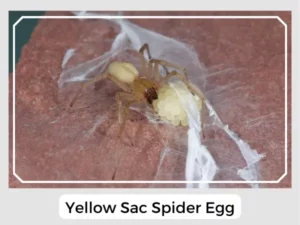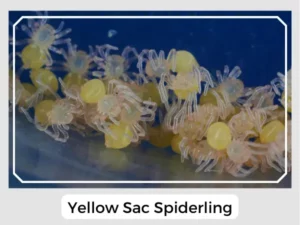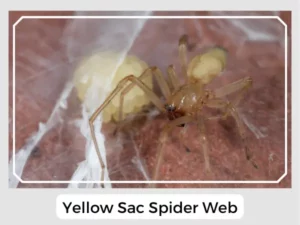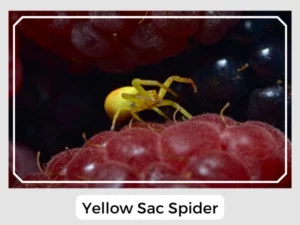Meet the yellow sac spider! It’s a spider that originally came from the Americas. Over time, it’s been a part of different spider families, and now it’s in the Eutichuridae family. We’re about to share some awesome facts about this spider.
Females produce about two egg sacs in general that may even go up to five, with each sac containing approximately 30 to 50 eggs. Laid in small silk tubes, the eggs are small and round-shaped, covered in white silk, deposited at the bottom of the leaves or other foliage. The mother spider stays with the eggs and shields them against any predator.

Photo Credit: Joseph Berger
Approximately 40 spiderlings hatch from a single sac mostly in spring. The juvenile spiders remain in the silken sac for a while after birth before being on their own completely. The mother spider stays with the spiderlings for approximately seventeen days, till they complete the first molt.

Photo Credit: Joseph Berger
The Yellow sac spider does not make webs, rather they build a sac or silken tube in protected places like beneath a leaf or at the meeting point of a ceiling and wall.

Photo Credit: Joseph Berger
The yellow sac spiders are venomous and their bites are said to contain cytotoxin, resulting in necrosis (cell injury where the cells in the living tissues die prematurely). However, the necrotic nature of the bite of this spider has been a subject of dispute. In fact, in one study conducted in Australia and the United States, it was seen that out of the 20 people bitten by this species, none of the bites had been of a necrotic nature.
Yes, Yellow Sac Spiders can bite. However, there have not been any reports of fatalities in humans from the bites of these spiders. Besides moderate pain, other common symptoms that the victim might suffer from include localized swelling and itching, while some could also encounter feelings of nausea and dizziness.
The bite of these spiders looks like a red welt and is often mistaken for that of a brown recluse, though the sting of the latter can be more painful and severe.
Though the symptoms go away between seven and ten days, in case of severity a medical practitioner’s help needs to be sought. Some normal home remedies people mention include applying an ice pack and hydrogen peroxide on the affected area.
These spiders are crucial in regulating insect populations, including those considered pests by humans. By consuming a variety of insects and even other spiders, they help maintain a balanced ecosystem. Their predatory nature is complemented by their agility and speed, which they use to hunt down prey.
Natural Predators: Yellow Sac Spiders have natural predators including birds, larger spiders, and sometimes small mammals. These predators help control the population of Yellow Sac Spiders and maintain ecological equilibrium.
Prey-Predator Dynamics: The Yellow Sac Spider’s role as a predator of insects and other spiders contributes to the intricate food web dynamics within their habitats. They are also prey, demonstrating the delicate balance of predator and prey relationships in nature.
Relationship with Humans: While venomous, the Yellow Sac Spider’s bite is not considered highly dangerous to humans. The typical reaction includes swelling, redness, and discomfort, with severe necrotic cases being rare and disputed. They occasionally venture into human dwellings, where they can be regarded as pest controllers.
| Other names | American yellow sac spider, Black-footed yellow sac spider |
| Lifespan | Males: 1 year; Females: 2 years or a little more |
| Distribution | Parts of the New World (Northern, Southern, and Central America as well as the West Indies) |
| Habitat | Underground debris, forest floors, trees, fruit orchards as well as several manmade structures |
| Diet | Their own eggs, other spiders bigger than their own size as well as a variety of insects |
In conclusion, the Yellow Sac Spider is a noteworthy species with a distinctive lifestyle and significant ecological role.

Meet the yellow sac spider! It’s a spider that originally came from the Americas. Over time, it’s been a part of different spider families, and now it’s in the Eutichuridae family. We’re about to share some awesome facts about this spider.
Females produce about two egg sacs in general that may even go up to five, with each sac containing approximately 30 to 50 eggs. Laid in small silk tubes, the eggs are small and round-shaped, covered in white silk, deposited at the bottom of the leaves or other foliage. The mother spider stays with the eggs and shields them against any predator.

Photo Credit: Joseph Berger
Approximately 40 spiderlings hatch from a single sac mostly in spring. The juvenile spiders remain in the silken sac for a while after birth before being on their own completely. The mother spider stays with the spiderlings for approximately seventeen days, till they complete the first molt.

Photo Credit: Joseph Berger
The Yellow sac spider does not make webs, rather they build a sac or silken tube in protected places like beneath a leaf or at the meeting point of a ceiling and wall.

Photo Credit: Joseph Berger
The yellow sac spiders are venomous and their bites are said to contain cytotoxin, resulting in necrosis (cell injury where the cells in the living tissues die prematurely). However, the necrotic nature of the bite of this spider has been a subject of dispute. In fact, in one study conducted in Australia and the United States, it was seen that out of the 20 people bitten by this species, none of the bites had been of a necrotic nature.
Yes, Yellow Sac Spiders can bite. However, there have not been any reports of fatalities in humans from the bites of these spiders. Besides moderate pain, other common symptoms that the victim might suffer from include localized swelling and itching, while some could also encounter feelings of nausea and dizziness.
The bite of these spiders looks like a red welt and is often mistaken for that of a brown recluse, though the sting of the latter can be more painful and severe.
Though the symptoms go away between seven and ten days, in case of severity a medical practitioner’s help needs to be sought. Some normal home remedies people mention include applying an ice pack and hydrogen peroxide on the affected area.
These spiders are crucial in regulating insect populations, including those considered pests by humans. By consuming a variety of insects and even other spiders, they help maintain a balanced ecosystem. Their predatory nature is complemented by their agility and speed, which they use to hunt down prey.
Natural Predators: Yellow Sac Spiders have natural predators including birds, larger spiders, and sometimes small mammals. These predators help control the population of Yellow Sac Spiders and maintain ecological equilibrium.
Prey-Predator Dynamics: The Yellow Sac Spider’s role as a predator of insects and other spiders contributes to the intricate food web dynamics within their habitats. They are also prey, demonstrating the delicate balance of predator and prey relationships in nature.
Relationship with Humans: While venomous, the Yellow Sac Spider’s bite is not considered highly dangerous to humans. The typical reaction includes swelling, redness, and discomfort, with severe necrotic cases being rare and disputed. They occasionally venture into human dwellings, where they can be regarded as pest controllers.
| Other names | American yellow sac spider, Black-footed yellow sac spider |
| Lifespan | Males: 1 year; Females: 2 years or a little more |
| Distribution | Parts of the New World (Northern, Southern, and Central America as well as the West Indies) |
| Habitat | Underground debris, forest floors, trees, fruit orchards as well as several manmade structures |
| Diet | Their own eggs, other spiders bigger than their own size as well as a variety of insects |
In conclusion, the Yellow Sac Spider is a noteworthy species with a distinctive lifestyle and significant ecological role.
